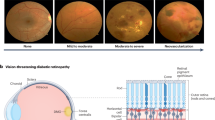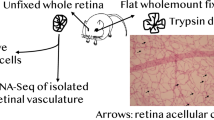Abstract
Purpose
To describe the relationship of retinal vascular calibre with diabetes and diabetic retinopathy in an Asian population.
Methods
A total of 3280 (78.7% response) subjects, aged 40–80 years, of Malay ethnicity residing in Singapore participated in this population-based, cross-sectional study. Retinal vascular calibre was measured and summarized using a validated computer programme from digital retinal photographs. Diabetic retinopathy signs were graded from photographs using the modified Airlie House classification.
Results
Of the 3004 subjects with data for this analysis, 682 (22.7%) had diabetes, of whom 194 (28.4%) had retinopathy. After multivariable adjustment, retinal arteriolar calibre was significantly wider in persons with diabetes (141 vs139 μm, P<0.001); venular calibre was not associated with diabetes (P=0.93). Among participants with diabetes, venular calibre increased from 218.7 μm in those without retinopathy to 231.1 μm in those with moderate and 231.4 μm in those with severe retinopathy (Pfor trend=<0.001); arteriolar calibre was not associated with diabetic retinopathy.
Conclusions
This study shows wider retinal arterioles in diabetes and wider venules in those with diabetic retinopathy in an Asian population. These findings confirm earlier data on white population, supporting the concept that a quantitative assessment of retinal vasculature may provide further insights into early diabetic microvascular damage.
Similar content being viewed by others
Log in or create a free account to read this content
Gain free access to this article, as well as selected content from this journal and more on nature.com
or
References
Nguyen TT, Wang JJ, Islam FM, Mitchell P, Tapp RJ, Zimmet PZ et al. Retinal arteriolar narrowing predicts incidence of diabetes: the Australian Diabetes, Obesity and Lifestyle (AusDiab) Study. Diabetes 2008; 57 (3): 536–539.
Rogers SL, Tikellis G, Cheung N, Tapp R, Shaw J, Zimmet PZ et al. Retinal arteriolar caliber predicts incident retinopathy: the Australian Diabetes, Obesity and Lifestyle (AusDiab) study. Diabetes Care 2008; 31 (4): 761–763.
Wong TY, Shankar A, Klein R, Klein BEK, Hubbard LD . Retinal arteriolar narrowing, hypertension, and subsequent risk of diabetes mellitus. Arch Intern Med 2005; 165 (9): 1060–1065.
Wong TY, Klein R, Sharrett AR, Schmidt MI, Pankow JS, Couper DJ et al., ARIC Investigators. Retinal arteriolar narrowing and risk of diabetes mellitus in middle-aged persons. JAMA 2002; 287 (19): 2528–2533.
Alibrahim E, Donaghue KC, Rogers S et al. Retinal vascular caliber and risk of retinopathy in young patients with type 1 diabetes. Ophthalmology 2006; 113 (9): 1499–1503.
Klein R, Klein BEK, Moss SE, Wong TY, Sharrett AR . Retinal vascular caliber in persons with type 2 diabetes: the Wisconsin Epidemiological Study of Diabetic Retinopathy: XX. Ophthalmology 2006; 113 (9): 1488–1498.
Nguyen TT, Wang JJ, Sharrett AR, Islam FM, Klein R, Klein BE et al. Relationship of retinal vascular caliber with diabetes and retinopathy: the Multi-Ethnic Study of Atherosclerosis (MESA). Diabetes Care 2008; 31 (3): 544–549.
Tikellis G, Wang JJ, Tapp R, Simpson R, Mitchell P, Zimmet PZ et al. The relationship of retinal vascular calibre to diabetes and retinopathy: the Australian Diabetes, Obesity and Lifestyle (AusDiab) study. Diabetologia 2007; 50 (11): 2263–2271.
Klein R, Klein BE, Moss SE, Wong TY, Hubbard L, Cruickshanks KJ et al. Retinal vascular abnormalities in persons with type 1 diabetes: the Wisconsin Epidemiologic Study of Diabetic Retinopathy: XVIII. Ophthalmology 2003; 110 (11): 2118–2125.
Kifley A, Wang JJ, Cugati S, Wong TY, Mitchell P . Retinal vascular caliber, diabetes, and retinopathy. Am J Ophthalmol 2007; 143 (6): 1024–1026.
Nguyen TT, Wang JJ, Wong TY . Retinal vascular changes in pre-diabetes and prehypertension: new findings and their research and clinical implications. Diabetes Care 2007; 30 (10): 2708–2715.
Foong AW, Saw SM, Loo JL, Shen S, Loon SC, Rosman M et al. Rationale and methodology for a population-based study of eye diseases in Malay people: The Singapore Malay eye study (SiMES). Ophthalmic Epidemiol 2007; 14 (1): 25–35.
Wong TY, Chong EW, Wong WL, Rosman M, Aung T, Loo JL et al., Singapore Malay Eye Study Team. Prevalence and causes of visual impairment and blindness in an urban Malay Population: the Singapore Malay Eye Study. Arch of Ophthalmol 2008; 126 (8): 1091–1099.
Wong TY, Knudtson MD, Klein R, Klein BE, Meuer SM, Hubbard LD . Computer-assisted measurement of retinal vessel diameters in the Beaver Dam Eye Study: methodology, correlation between eyes, and effect of refractive errors. Ophthalmology 2004; 111 (6): 1183–1190.
Diabetic retinopathy study. Report Number 6. Design, methods, and baseline results. Report Number 7. A modification of the Airlie House classification of diabetic retinopathy. Prepared by the Diabetic Retinopathy. Invest Ophthalmol Vis Sci 1981; 21 (1 Pt 2): 1–226.
Wong TY, Cheung N, Tay WT, Wang JJ, Aung T, Saw SM et al. Prevalence and risk factors for diabetic retinopathy. The Singapore Malay Eye Study. Ophthalmology 2008; 48 (1): 52–57.
Leow BG . Singapore Census of Population 2000: Statistical Release 1—Demographic Characteristics. Department of Statistics: Government of Singapore, Singapore, 2001.
Liew G, Sharrett AR, Kronmal R, Klein R, Wong TY, Mitchell P et al. Measurement of retinal vascular caliber: issues and alternatives to using the arteriole to venule ratio. Invest Ophthalmol Vis Sci 2007; 48 (1): 52–57.
Wong TY, Klein R, Islam FM, Cotch MF, Folsom AR, Klein BE et al. Diabetic retinopathy in a multi-ethnic cohort in the United States. Am J Ophthalmol 2006; 141 (3): 446–455.
Sun C, Liew G, Wang JJ, Mitchell P, Saw SM, Aung T et al. Retinal vascular caliber, blood pressure, and cardiovascular risk factors in an Asian population: the Singapore Malay Eye Study. Invest Ophthalmol Vis Sci 2008; 49 (5): 1784–1790.
Mandecka A, Dawczynski J, Blum M, Müller N, Kloos C, Wolf G et al. Influence of flickering light on the retinal vessels in diabetic patients. Diabetes Care 2007; 30 (12): 3048–3052.
Grunwald JE, Brucker AJ, Schwartz SS, Braunstein SN, Baker L, Petrig BL et al. Diabetic glycemic control and retinal blood flow. Diabetes 1990; 39 (5): 602–607.
Tamai K, Matsubara A, Tomida K, Matsuda Y, Morita H, Armstrong D et al. Lipid hydroperoxide stimulates leukocyte-endothelium interaction in the retinal microcirculation. Exp Eye Res 2002; 75 (1): 69–75.
Kolodjaschna J, Berisha F, Lung S, Schaller G, Polska E, Jilma B et al. LPS-induced microvascular leukocytosis can be assessed by blue-field entoptic phenomenon. Am J Physiol Heart Circ Physiol 2004; 287 (2): H691–H694.
Chester AH, Borland JA, Buttery LD, Mitchell JA, Cunningham DA, Hafizi S et al. Induction of nitric oxide synthase in human vascular smooth muscle: interactions between proinflammatory cytokines. Cardiovasc Res 1998; 38 (3): 814–821.
Miyamoto K, Khosrof S, Bursell SE, Rohan R, Murata T, Clermont AC et al. Prevention of leukostasis and vascular leakage in streptozotocin-induced diabetic retinopathy via intercellular adhesion molecule-1 inhibition. Proc Natl Acad Sci USA 1999; 96 (19): 10836–10841.
Izuora KE, Chase HP, Jackson WE, Coll JR, Osberg IM, Gottlieb PA et al. Inflammatory markers and diabetic retinopathy in type 1 diabetes. Diabetes Care 2005; 28 (3): 714–715.
Joussen AM, Poulaki V, Le ML, Koizumi K, Esser C, Janicki H et al. A central role for inflammation in the pathogenesis of diabetic retinopathy. FASEB J 2004; 18 (12): 1450–1452.
Wong TY, Mitchell P . Hypertensive retinopathy. N Engl J Med 2004; 351 (22): 2310–2317.
Acknowledgements
We thank the staff and participants in the SiMES study for their important contributions. This study was supported by the National Medical Research Council Grants No 0796/2003, 0863/2004 and CSI/0002/2005 and Biomedical Research Council Grant No 501/1/25-5. Additional support was provided by the Singapore Tissue Network and the Ministry of Health, Singapore.
Author information
Authors and Affiliations
Corresponding author
Additional information
Conflict/proprietary interest
None.
Rights and permissions
About this article
Cite this article
Islam, F., Nguyen, T., Wang, J. et al. Quantitative retinal vascular calibre changes in diabetes and retinopathy: the Singapore Malay eye study. Eye 23, 1719–1724 (2009). https://doi.org/10.1038/eye.2008.362
Received:
Accepted:
Published:
Issue date:
DOI: https://doi.org/10.1038/eye.2008.362
Keywords
This article is cited by
-
Retinal microvascular associations with cardiometabolic risk factors differ by diabetes status: results from the UK Biobank
Diabetologia (2022)
-
A stronger association of diabetes mellitus with impaired hyperaemia using a novel ECG-gated device compared with peripheral arterial tonometry
International Ophthalmology (2022)
-
A deep-learning system for the assessment of cardiovascular disease risk via the measurement of retinal-vessel calibre
Nature Biomedical Engineering (2020)
-
Type 2 diabetes and HbA1c are independently associated with wider retinal arterioles: the Maastricht study
Diabetologia (2020)
-
Characteristics of the retinal microvasculature in association with cardiovascular risk markers in children with overweight, obesity and morbid obesity
Scientific Reports (2018)



